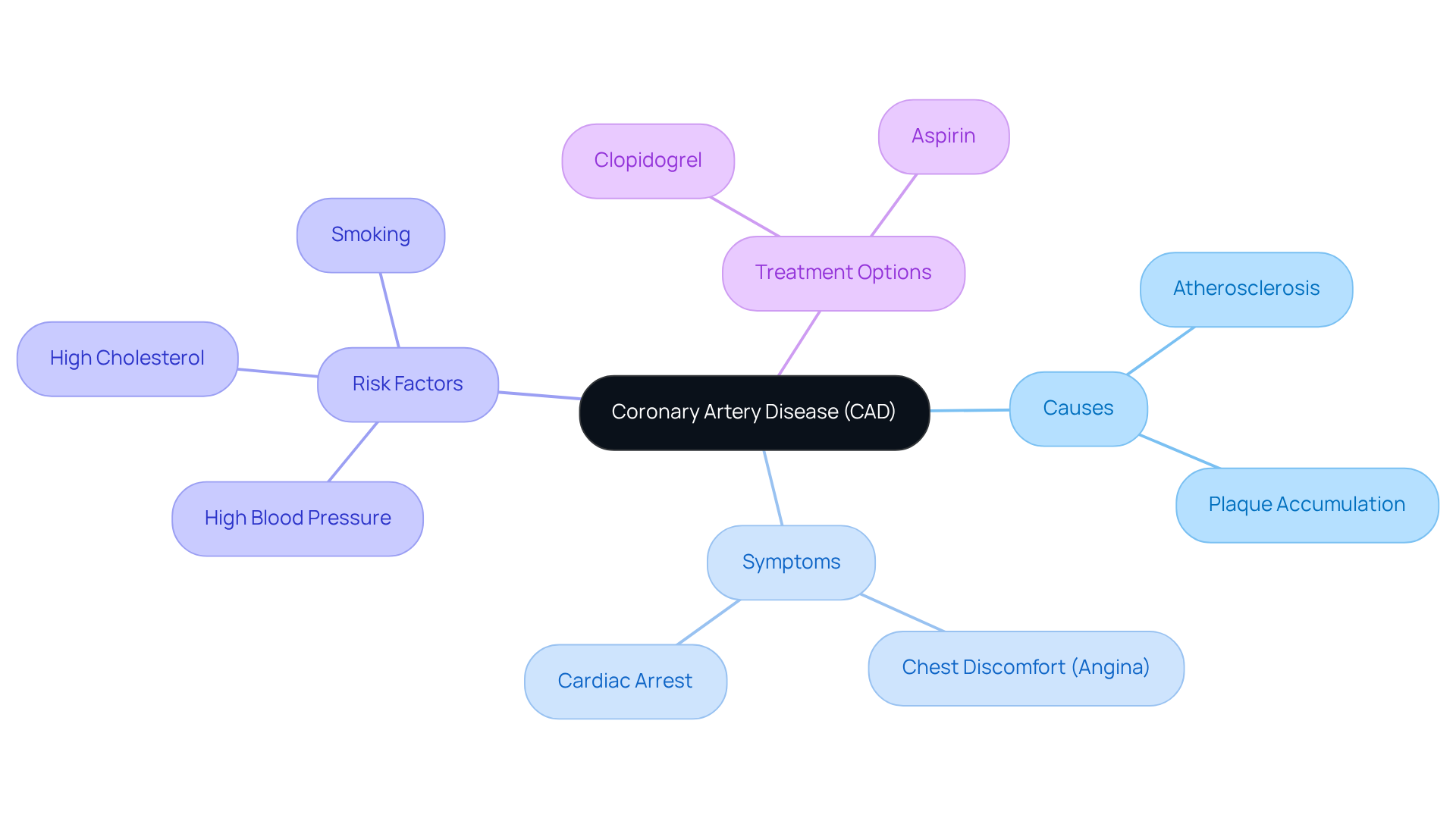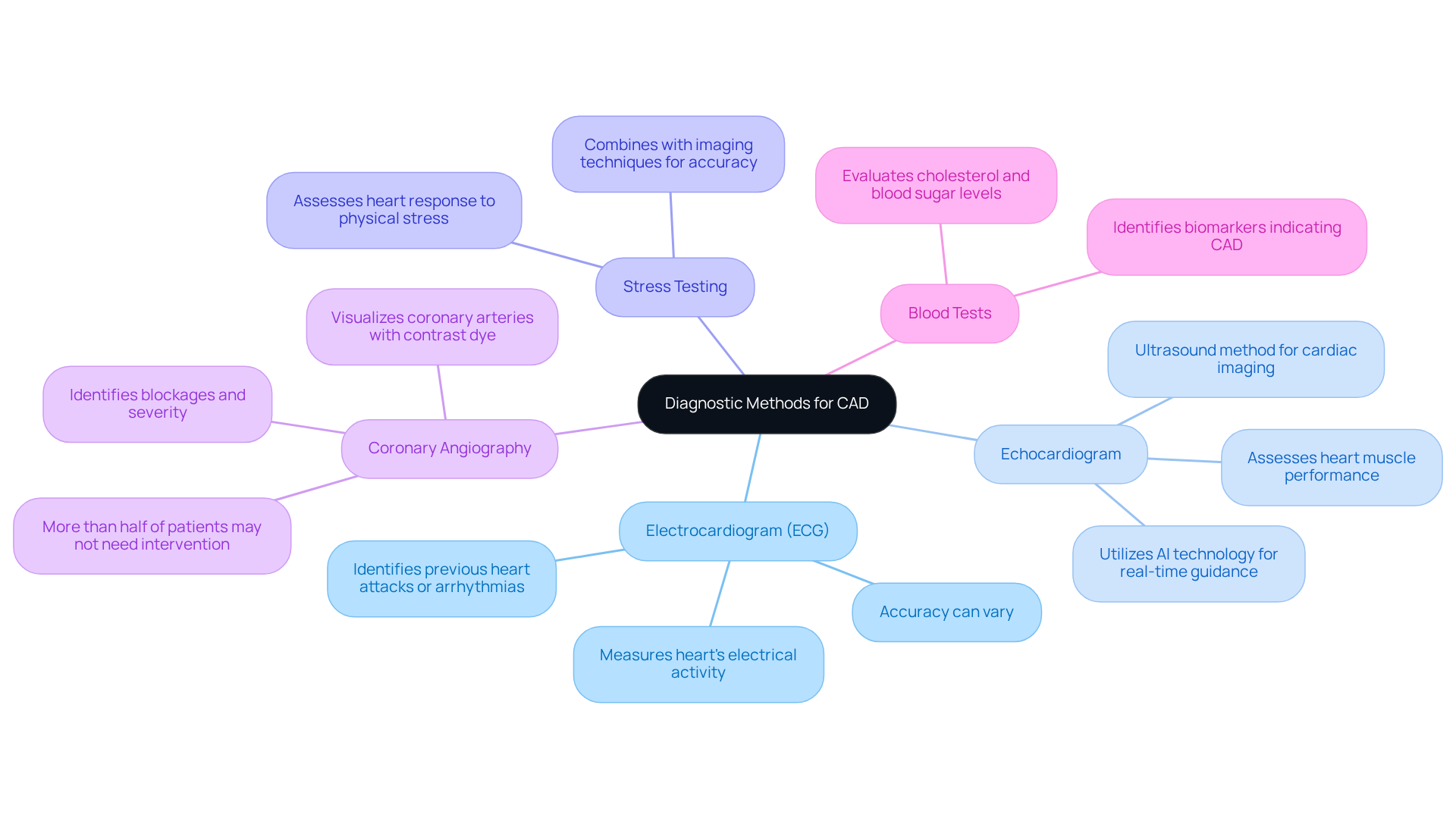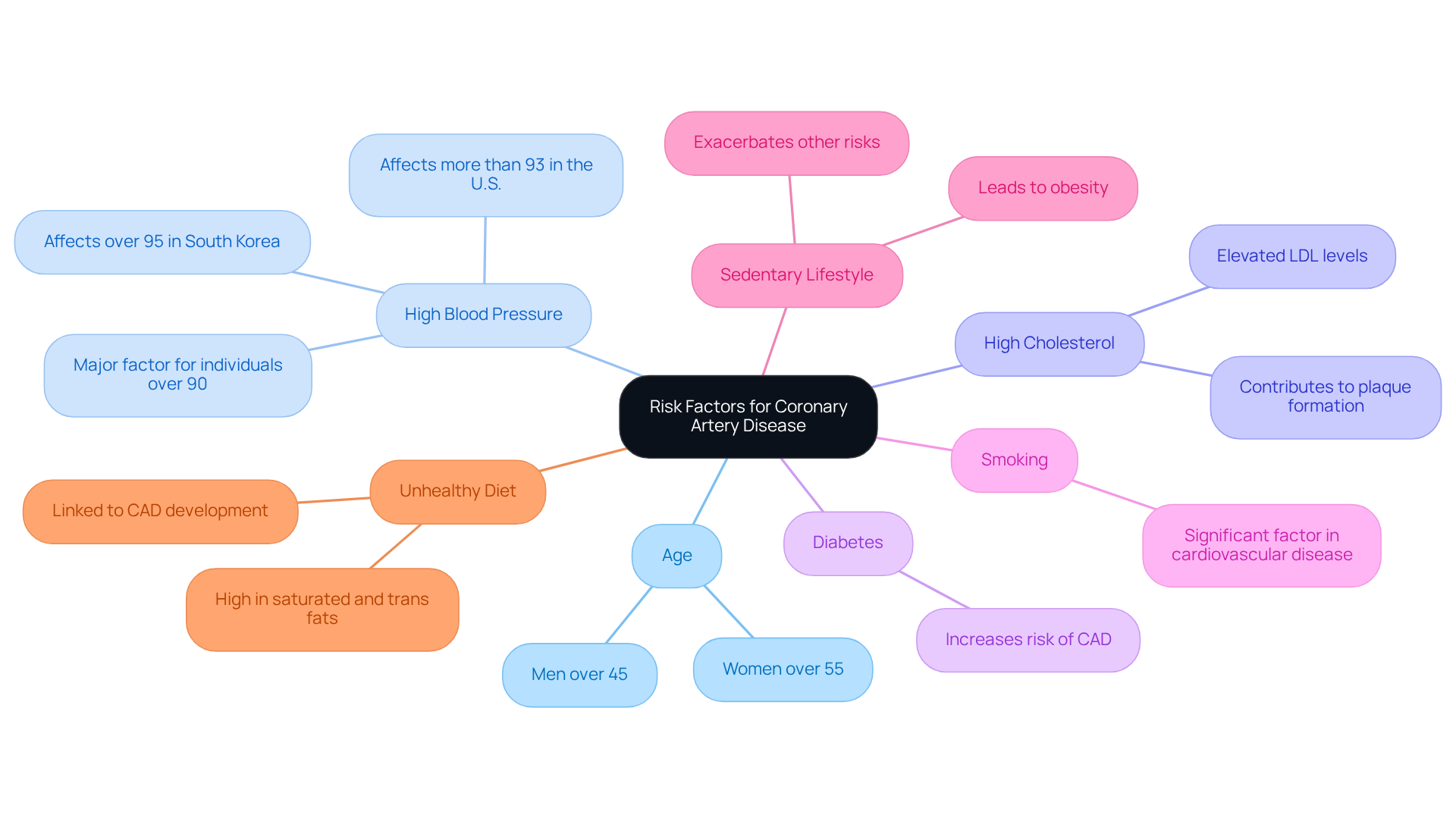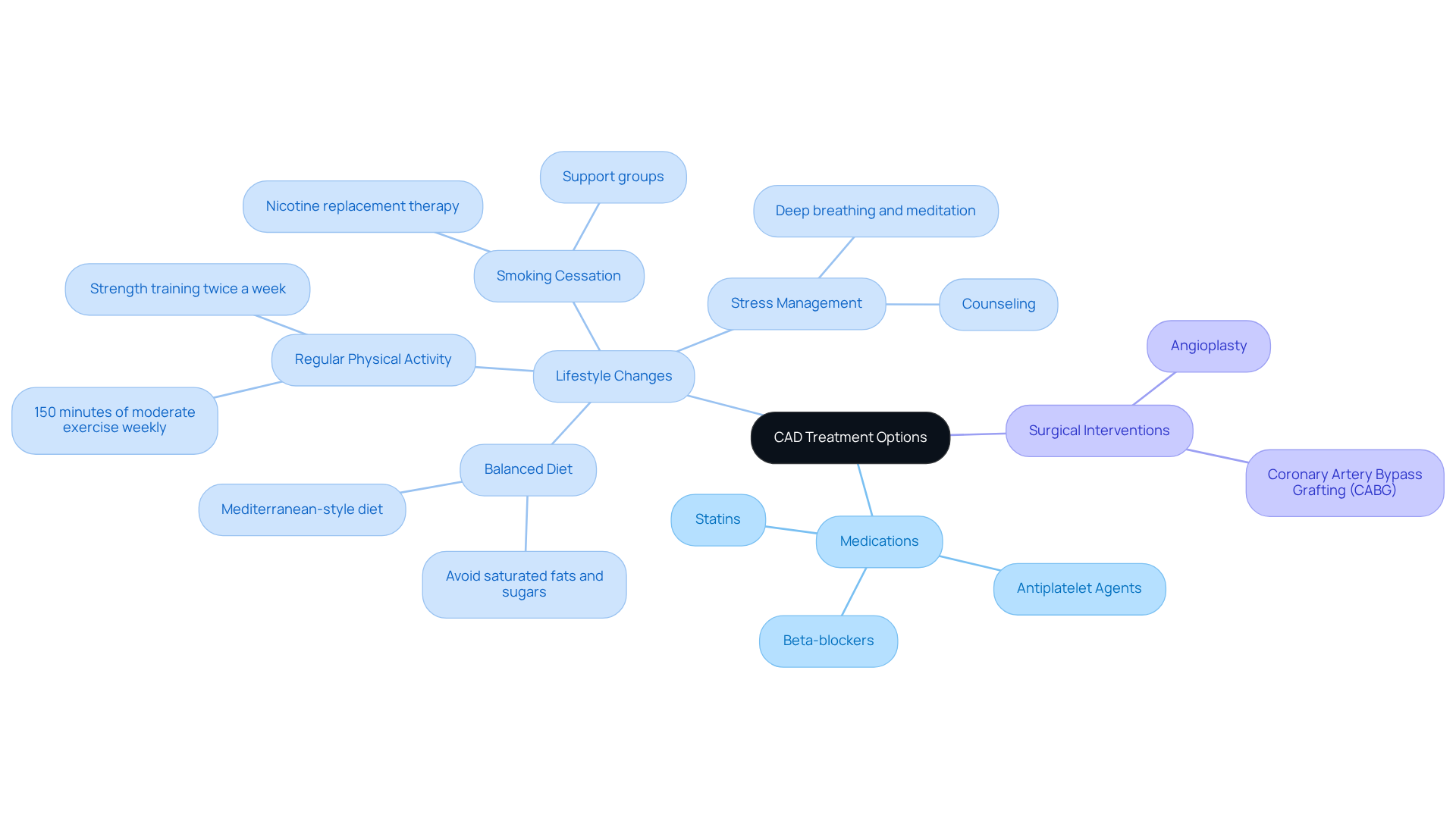


In our journey towards better heart health, understanding the steps involved in diagnosing Coronary Artery Disease (CAD) is crucial. This article gently outlines four key steps that can significantly enhance your heart health. We emphasize the importance of comprehensive assessment methods, such as:
These diagnostic tools are not just technical procedures; they provide critical insights into your heart function and risk factors.
By utilizing these assessments, healthcare providers can create personalized treatment plans tailored to your unique needs. This approach can lead to significant improvements in patient outcomes, ensuring that you receive the care that is right for you. It’s understandable to feel apprehensive about these procedures, but rest assured, they are designed to support your health and well-being.
We encourage you to reflect on your heart health and consider reaching out for a comprehensive assessment. Remember, you are not alone in this journey. There are compassionate professionals ready to guide you through each step, ensuring you feel valued and supported as you take charge of your heart health.
Understanding coronary artery disease (CAD) is essential, as it is the most common form of cardiovascular disease, particularly affecting our older adults. With risk factors such as high blood pressure, high cholesterol, and lifestyle choices playing significant roles, a proactive approach to diagnosis and management can lead to improved heart health outcomes.
But how can individuals navigate the complexities of CAD diagnosis and treatment in a world filled with evolving medical technologies and personalized care strategies?
This article explores the essential steps for diagnosing CAD, highlighting the latest methods and lifestyle changes that can empower individuals to take charge of their cardiovascular health.
Remember, you are not alone in this journey, and there are many resources available to support you.
Coronary Artery Disease (CAD) is a common condition that many may face, characterized by the narrowing or blockage of the coronary arteries, which supply vital blood to the heart muscle. This narrowing primarily stems from atherosclerosis, where fatty deposits, or plaques, accumulate on the artery walls. As these plaques grow, they can hinder blood flow, leading to symptoms such as chest discomfort, known as angina, and in severe cases, even cardiac arrests. It's important to understand that CAD is the most prevalent type of cardiovascular disease, affecting over 70% of individuals aged 60 and older.
Recognizing the risk factors associated with CAD, including:
is crucial for prevention and effective management. Have you considered how these factors may impact your health? Recent research indicates that clopidogrel may be more effective than aspirin in preventing serious cardiovascular incidents and strokes in patients with CAD. This highlights the importance of personalized treatment strategies tailored to your unique needs.
Understanding is essential for early intervention, particularly for older patients who might exhibit unusual symptoms. By being aware of these signs, you can take proactive steps towards enhancing your cardiovascular health. Remember, you are not alone in this journey; support and care are available to help you navigate your health concerns. Together, we can work towards a healthier future.

Understanding coronary artery disease (CAD) can be daunting, but a thorough approach to diagnosis can help ease your concerns. The process of CAD diagnosis involves a careful assessment of your medical history, physical examinations, and various diagnostic tests. Here are some common methods used to help you understand your heart health:
Each of these diagnostic methods plays a significant role in painting a comprehensive picture of your cardiovascular health. The integration of advanced imaging techniques, such as the HeartFlow Analysis, which has been utilized in over 60,000 patients, has improved the identification of those who may not need invasive procedures. This not only enhances your care but also reduces unnecessary interventions.
Furthermore, our AI-powered diagnostic tools facilitate early detection and support seamless care coordination from admission through discharge, ensuring you receive the most effective and personalized care possible. As the field of cardiology evolves, ongoing research continues to refine these diagnostic practices, ensuring that patients at Amavita Heart and Vascular Health receive the highest standard of care. Remember, you are not alone in this journey—our dedicated team is here to support you every step of the way.

The CAD diagnosis is influenced by several important contributors, many of which can be positively altered through lifestyle modifications and proactive medical measures. Understanding these elements is vital for of CAD diagnosis, especially in older adults. The primary risk factors include:
Recent studies indicate that over 99% of individuals who experience heart attacks or strokes had at least one suboptimal condition prior to their event. For instance, embracing a Mediterranean diet and increasing physical activity have shown promising results in lowering the likelihood of CAD. Health professionals encourage a focus on adjustable risks, as nearly all cardiovascular outcomes are linked to CAD diagnosis through exposure to these elements.
Amavita offers comprehensive programs, including the Optimal Program at $416/month ($4,995 yearly), which features advanced cardiovascular health monitoring and personalized consultations to help manage these challenges effectively. Additionally, the CardioElite™ program provides real-time diagnostic data and 24/7 cardiology consultation, enhancing proactive patient management and reducing emergency workload. As noted by Philip Greenland, MD, "The objective now is to focus more on discovering methods to manage these adjustable threats rather than to deviate in chasing other elements that are not easily treatable and not causal." This highlights the crucial importance of addressing these risk factors to improve cardiovascular health and prevent CAD diagnosis.

After receiving a CAD diagnosis, it’s essential to create a comprehensive treatment plan that not only manages the condition effectively but also enhances your quality of life. This plan typically includes several key elements:
Medications: Many patients are prescribed a combination of medications, such as statins to lower cholesterol, antiplatelet agents to help prevent blood clots, and beta-blockers to manage blood pressure. These medications are vital in stabilizing your condition and reducing the risk of future cardiac events.
Lifestyle Changes: Embracing heart-healthy habits is crucial for improving your overall health. Here are some recommended lifestyle modifications:
Surgical Interventions: In some cases, procedures like angioplasty or coronary artery bypass grafting (CABG) may be necessary to restore blood flow. These interventions can provide immediate relief from symptoms and improve overall heart function.
By integrating these treatment strategies with lifestyle changes, you can experience significant improvements in your heart health and overall well-being. Many individuals who commit to these changes share that they often enjoy a better quality of life and reduced symptoms, highlighting the importance of a proactive approach to managing CAD. Remember, you are not alone in this journey, and support is always available as you work towards better health.

Understanding the intricacies of Coronary Artery Disease (CAD) is vital for anyone looking to enhance their heart health. This article highlights the importance of recognizing CAD, the diagnostic methods available, the significant risk factors involved, and the comprehensive treatment options that can lead to improved outcomes. By being informed about CAD, individuals can take proactive steps toward better cardiovascular health.
Key insights include the need for early diagnosis through various tests such as:
These collectively provide a clearer picture of heart health. Furthermore, recognizing and addressing risk factors like:
Plays a crucial role in preventing and managing CAD. Integrating lifestyle changes with medical interventions can significantly enhance the quality of life for those diagnosed with this condition.
Ultimately, the journey toward managing CAD is a collaborative effort that requires awareness, education, and action. Embracing heart-healthy habits, staying informed about the latest diagnostic technologies, and actively participating in treatment plans can empower individuals to take control of their cardiovascular health. The message is clear: proactive engagement in one’s health can lead to a brighter, healthier future.
What is Coronary Artery Disease (CAD)?
Coronary Artery Disease (CAD) is a common condition characterized by the narrowing or blockage of the coronary arteries, which supply blood to the heart muscle. This condition primarily results from atherosclerosis, where fatty deposits accumulate on the artery walls.
What causes the narrowing of the coronary arteries in CAD?
The narrowing of the coronary arteries in CAD is primarily caused by atherosclerosis, which involves the buildup of fatty deposits, or plaques, on the artery walls.
What are the symptoms of CAD?
Symptoms of CAD can include chest discomfort, known as angina, and in severe cases, it may lead to cardiac arrests.
How prevalent is CAD among older adults?
CAD is the most prevalent type of cardiovascular disease, affecting over 70% of individuals aged 60 and older.
What are the risk factors associated with CAD?
Key risk factors for CAD include high blood pressure, high cholesterol, and smoking.
What recent research findings are relevant to CAD treatment?
Recent research indicates that clopidogrel may be more effective than aspirin in preventing serious cardiovascular incidents and strokes in patients with CAD, emphasizing the need for personalized treatment strategies.
Why is understanding CAD diagnosis important?
Understanding CAD diagnosis is essential for early intervention, especially for older patients who may exhibit unusual symptoms, allowing for proactive steps towards enhancing cardiovascular health.
What support is available for individuals concerned about CAD?
Support and care are available to help individuals navigate their health concerns related to CAD, promoting a healthier future together.